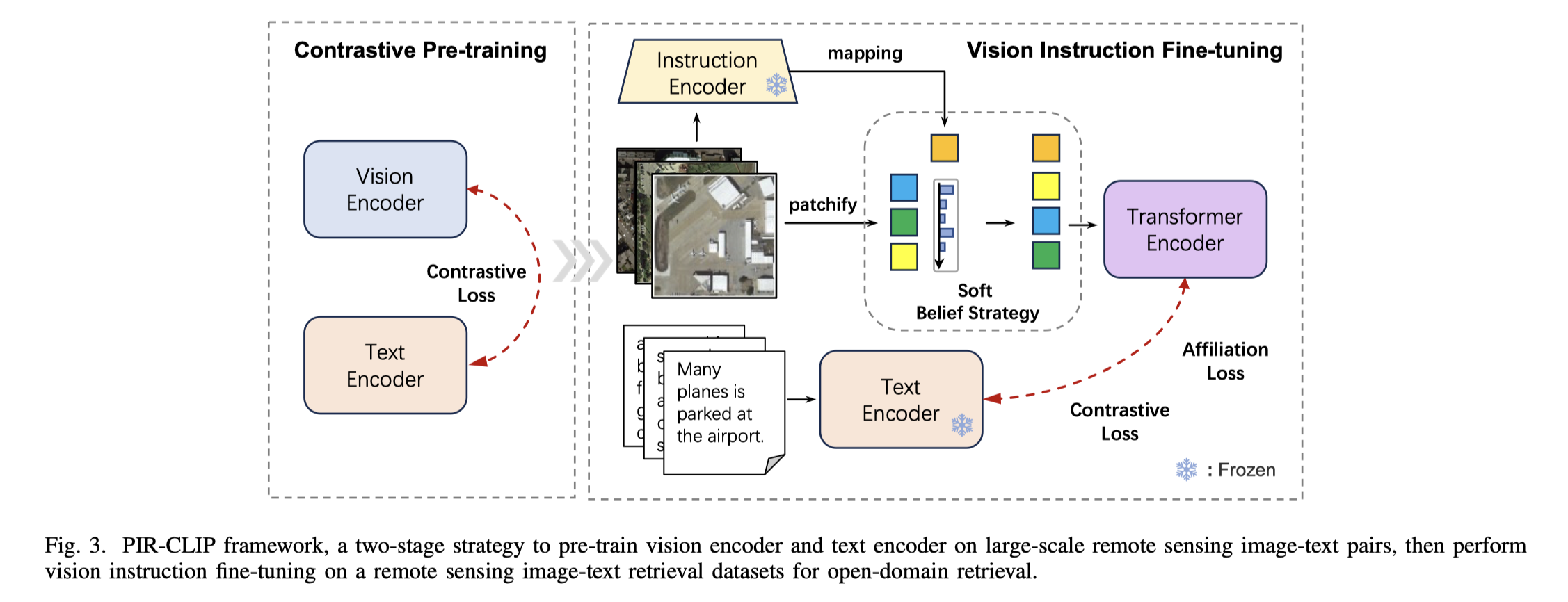By Jiancheng Pan, Muyuan Ma, Qing Ma, Cong Bai, Shengyong Chen.
This repo is the official implementation of "PIR-CLIP: Remote Sensing Image-Text Retrieval with Prior Instruction Representation Learning".
Remote sensing image-text retrieval constitutes a foundational aspect of remote sensing interpretation tasks, facilitating the alignment of vision and language representations. This paper introduces a prior instruction representation (PIR) learning paradigm that draws on prior knowledge to instruct adaptive learning of vision and text representations. Based on PIR, a domain-adapted remote sensing image-text retrieval framework PIR-ITR is designed to address semantic noise issues in vision-language understanding tasks. However, with massive additional data for pre-training the vision-language foundation model, remote sensing image-text retrieval is further developed into an open-domain retrieval task. Continuing with the above, we propose PIR-CLIP, a domain-specific CLIP-based framework for remote sensing image-text retrieval, to address semantic noise in remote sensing vision-language representations and further improve open-domain retrieval performance. In vision representation, Vision Instruction Representation (VIR) based on Spatial-PAE utilizes the prior-guided knowledge of the remote sensing scene recognition by building a belief matrix to select key features for reducing the impact of semantic noise. In text representation, Language Cycle Attention (LCA) based on Temporal-PAE uses the previous time step to cyclically activate the current time step to enhance text representation capability. A cluster-wise Affiliation Loss (AL) is proposed to constrain the inter-classes and to reduce the semantic confusion zones in the common subspace. Comprehensive experiments demonstrate that PIR could enhance vision and text representations and outperform the state-of-the-art methods of closed-domain and open-domain retrieval on two benchmark datasets, RSICD and RSITMD.

base on open_clip environments, you can click here open_clip.
If using Affiliation loss, add is_aff_loss where the label information is obtained by image_name from datasets. For example, we can train PIR-CLIP using the follow commad:
python -m training.main \
--save-frequency 1 \
--report-to tensorboard \
--train-data="path/to/webdataset/tar" \
--dataset-resampled \
--train-num-samples num_dataset \
--dataset-type webdataset \
--warmup 10000 \
--batch-size=512\
--precision amp \
--lr=1e-5 \
--wd=0.5 \
--epochs=20 \
--workers=4 \
--model=PIR \
--is_aff_loss
or parallel training as
torchrun --nproc_per_node 2 \
--rdzv_endpoint=$HOSTE_NODE_ADDR \
-m training.main \
--save-frequency 1 \
...
Retrieval evaluation on CLIP Benchmark and checkpoints can download from here: Baidu Disk.
python retrieval.py \
--model-name "PIR" \
--retrieval-images-dir "path/to/images" \
--retrieval-json-dir "path/to/dataset.json" \
--remoteclip-path "./checkpoints/PIR-CLIP_RET-3.pt"
All experiments are based on RSITMD, RSICD datasets and pre-training dataset RS5M.
If you find this code useful for your work or use it in your project, please cite our paper as:
@inproceedings{pan2023prior,
title={A Prior Instruction Representation Framework for Remote Sensing Image-text Retrieval},
author={Pan, Jiancheng and Ma, Qing and Bai, Cong},
booktitle={Proceedings of the 31st ACM International Conference on Multimedia},
pages={611--620},
year={2023}
}
@misc{pan2024pir,
title={PIR: Remote Sensing Image-Text Retrieval with Prior Instruction Representation Learning},
author={Jiancheng Pan and Muyuan Ma and Qing Ma and Cong Bai and Shengyong Chen},
year={2024},
eprint={2405.10160},
archivePrefix={arXiv},
primaryClass={cs.CV}
}